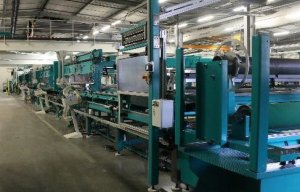
Chomarat invests in carbon multiaxial technology
The conversations mainly focused on machines for producing multiaxial textiles, the company reports.

2nd May 2017
Innovation in Textiles
|
Obertshausen
Karl Mayer Technische Textilien, a leading supplier to the composites sector, exhibited its latest technological solutions at the JEC World exhibition, which took place in Paris, earlier this spring and the German company reports strong interest in its technologies.
The leading textile machinery manufacturer supplies biaxial and multiaxial warp knitting machines for producing dry, non-crimp fabrics (NCFs) for the composites sector, as well as fibre spreading machines for the production of unidirectional fibre tapes made from a wide range of technical filament yarns. The company debuted at the JEC World trade show last year.
“Together with Techtextil in Frankfurt, JEC World is the most important fair for us,” said Hagen Lotzmann, the Sales Manager of Karl Mayer Technische Textilien. “We spoke to all of our most important clients in Paris, most of whom were also exhibiting at the show. We also made many new contacts, mainly from European companies.”
The conversations mainly focused on machines for producing multiaxial textiles, the company reports. The manufacturer can supply the Biaxtronic CO and COP BIAX 2 for producing biaxial textiles. The COP MAX machines are also available for producing multiaxial reinforcing structures: the flexible COP MAX 4 can produce multilayered, multiaxial textiles with angles of +20° to -20°, and the COP MAX 5 is designed specifically for processing carbon fibres. Very thin, homogeneous structures with extremely low weights can be produced on this machine, the company reports.
“To produce lightweight, multiaxial structures, many manufacturers want to use industrial, heavy and consequently cost-effective fibre materials and were, therefore, keen to talk to Hagen Lotzmann about fibre spreading,” the manufacturer explains.
The company can supply UD 500 and UD 700 systems for spreading and equalising the fibre tapes and these can process continuous filament yarns made from carbon, as well as from glass and aramid. Multiaxial glass-fibre textiles are used mainly in the blades of wind turbines and according to Hagen Lotzmann, the renewable energy sector continues to flourish. “Everyone has a great deal to do,” he said.
Many discussions were also held with representatives and suppliers from the automotive and aerospace sectors. A number of new development trends could be detected during the course of the conversations, and the picture of a highly innovative sector emerged, according to the manufacturer. “Our customers came to us with a variety of ideas and they are looking for solutions to cater for extremely specific applications,” concluded Hagen Lotzmann.

Business intelligence for the fibre, textiles and apparel industries: technologies, innovations, markets, investments, trade policy, sourcing, strategy...
Find out more